|
|
Preview 3G smartphone Nokia N80
Nokia N80. Live pictures
In already distant November 2001, the company of Nokia announced its first Series 60 phone (now S60), which was called 7650. However from the very moment the first smartphones appeared in its product line, the company did not divide them into a separate class, but positioned as the most functional phones. Some functions and phone's capabilities were placed to the foreground, but not capabilities of the operating system (they actually were held back in order not to scare a customer away with difficult organization). That happened to Nokia 7650 and to other 26 smartphones produced in following years, and still the company revised its stand.
Which function do you think they emphasized mostly on when introducing Nokia 7610? According to the manufacturer and marketing specialists, this model equipped with MMS support and integrated camera was to establish a "new epoch" of mobile communication, when all users passed to MMS from SMS. Then operators dreamed of fantastic benefits, growth of ARPU, this belief was infinite. Be sure, "a large colour display" and "radically improved interface" were also stressed, however the company supposed that MMS was the key function. We all know that MMS didn't justify hopes. And here we won't discuss those various reasons.
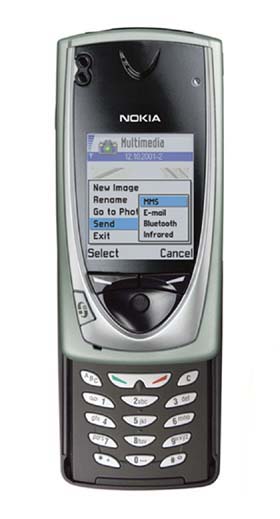
And even despite the failure of MMS idea, this first smartphone should be rightfully considered one of the key models in the history of the company. Nokia 7650 looked very suitably in "Minority report" by Steven Spilberg, the action looked fascinating and futuristic. The movie premier fell on the 21 of June 2002 and exactly in five days the phone was put on the market. Also remember external Nokia's advertisement concerning the film. And thus the movie became some kind of an advertisement of Nokia 7650. Also the target group was selected just right - an image of a fantastic device from "the future" was projected on the phone, and its functionality was squared in the customer's eyes.
Why was a slider form-factor selected? The reason is not its fashion attractiveness, only later the company of Samsung will obtain such popularity for it. It happened so that for design moment the element base prevented from making a candybar with acceptable body height, which formed the main reason. And during the line and element base development, we can see the company's attempts to place all components in a standard candybar shape. Nokia has not recalled the slider form-factor till now, which proves the reasons why this body shape was selected for the first smartphone. Generally speaking, it is possible to call only two slider smartphones, which are Samsung D720 and Nokia 7650. Some less successful models were introduced after Nokia 7650; I mean they were not as significant as the first slider. And Nokia 6630 changed the situation. In fact, it was logical to suppose the company would release one more slider smartphone and now the design will be dictated by the form-factor popularity and a necessity to expand the product line. So we had to wait for four years before Nokia N80 was officially announced at the November Nokia Mobility Conference 2005 in Barcelona.
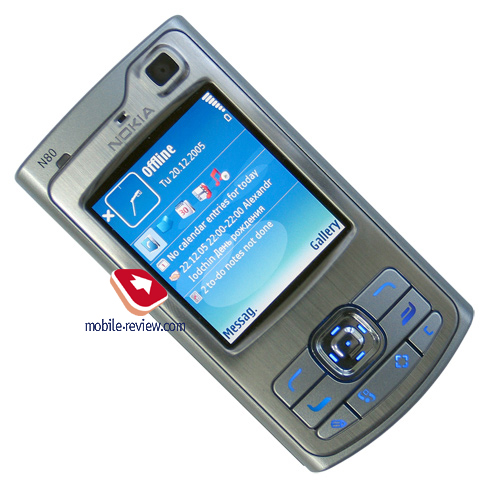
And now let us return to the past, exactly in September 2005. The first (computer-generated) photos were published at mobile-review.com. And since that the model has been actively discussed, though treated as some kind of a "dream phone". Not everybody believed it is real, especially that concerned specifications.
Just after the announcement discussions flared up at specialized forums and the majority of participants confirmed that would be a hit. And the model is truly the most functional for today considering paper specifications (the screen, Wi-Fi, UPnP support, 3MP camera). And now let us look at the device sensibly and estimate its potential and perspectives.
Well, what caused such a flurry, why so much attention is plaid to the model, let us list differences from other models (we consider direct and indirect rivals):
- The model distinguishes the slider form-factor;
- That is the first time Nokia's phone is equipped with a 3MP camera, which explains this lion's share of attention. The user expects this camera feature better characteristics than in Nokia N90 at acceptable size and weight;
- The best display among smartphones;
- S60 version 3 FP1;
- Wi-Fi support;
- Support for quite new UPnP standard.
Will the model hit the sales? The answer is more yes than no. Unfortunately, we cannot give a single meaning conclusion yet due to raw samples of the N80 given for tests - we observed a body backlash, the software installed is S60 v3 without FP1, it is slow, serious problems with camera (including low photo quality), short battery life unstable Wi-Fi work and so on. And as soon as we get a commercial workable device we will publish a complete review with all points highlighted. However even now we can provide preliminary conclusions.

Take the phone in hands and admit the phone size is not big; the dimensions are quite acceptable if compared with smartphones. It is smaller than Nokia 6680. However it will look large if placed near a usual slider phone. The dimensions form 95.5x50x23.5 mm, and the body thickens to 26 mm around the camera module, which is quite a negative factor as a user has already got used to slim solutions. The general feeling of the phone is equal to Nokia 7650, which is bigger (114x56x26 mm). The weight is average for smartphones and reaches 134 g. This device is comfortable to carry almost in any way - you won't feel it in a pocket of your jacket, in a shirt pocket it will be noticeable and mainly due to its thickness it will be felt in jeans.

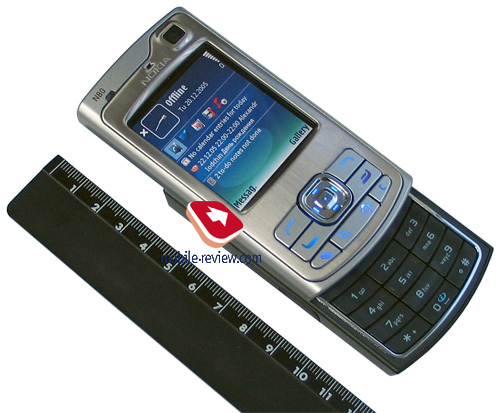
The design is rather strict, without excesses and simplicity is at the head (in a good sense of the word, the same that concerned plain design of Sony Ericsson t610/t630). Top and bottom ends are splay. This model has peculiar design, which can be called classical or business. However tastes differ and some people will be delighted, while someone may prefer round shape of Samsung D500/D600.
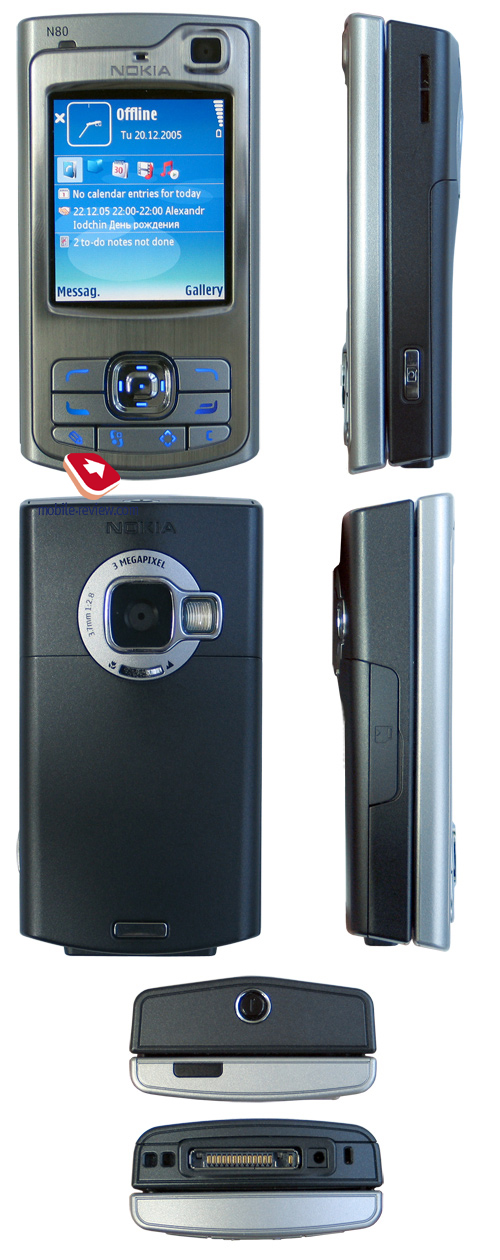
The top panel is made of silvery plastic with metallic border rounding the screen and the keys. The Metal pleasantly gleams in the sun, giving its origins away. Generally the body is reliable, the assembly is good with unnoticeable joints (however now we observed slight backlash of the body parts).
You can perform all actions with the phone, except only for entering text and phone number, without opening. A 5D navigational button, surrounded by a collection of two soft-keys and call accept and cancel buttons, is put under the screen. The bottom line represents a standard set of control elements and a media key button for fast access to the main functions.

You may open the phone with one hand, and thus reveal the keypad. The movement is smooth, however automatic finishing is absent. Though the keys are located closely to each other, you will experience no problems with them. Also you won't press two buttons at the same time by pressing their joint, as the keys may not be pressed in this area at all. The area to press is smaller than the visible one. The keypad is convenient, it is not necessary to get accustomed or adapted to it. The only cavil that may rise is the key motion is less than one would like. The blue backlighting is well seen in the dark, it is automatically adjusted by the light sensor.
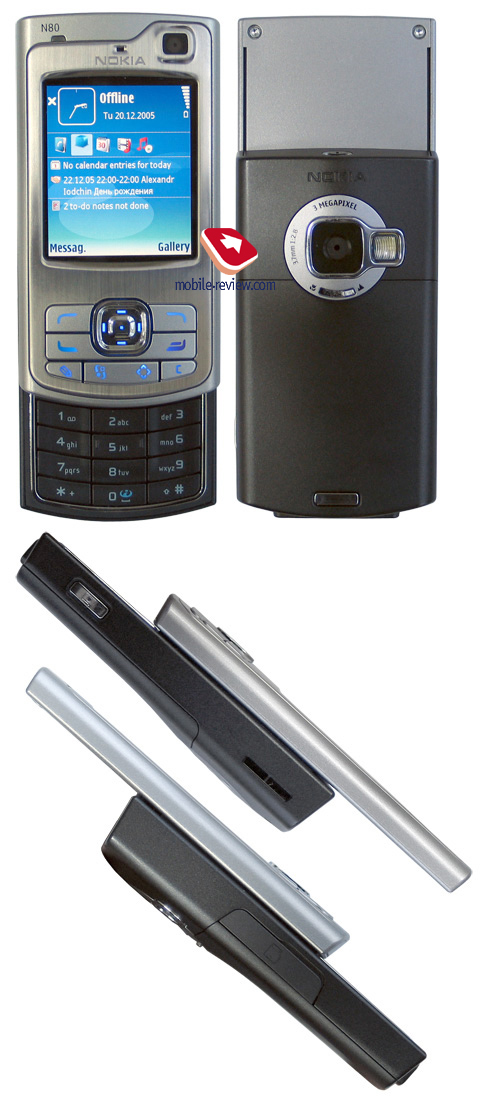
A CIF camera for videocalls found room under the screen. The back cover features the camera gap and the battery compartment, while on the top end an IrDA gap and a power button are placed.
A miniSD connector closed with a plastic cover is on the left facet. Gradually the company transfers all its products to this type of memory, rejecting MMCmobile. The maximally accessible capacity of miniSD card is 2 GB. In fact, no problems with buying the maximum volume card may appear by the release moment. For better vision of a memory card price below we provide current FOB prices of Taiwanese manufacturers (without shipment, customs and extra charge). By the way, wholesale price has been growing for the last half year due to high demand on this memory type, and the maximum capacity cards are in shortage:
- MiniSD 128 Mb Ц $10.40
- MiniSD 256 MB Ц $16.80
- MiniSD 512 MB Ц $29.80
- MiniSD 1 √б Ц $51.50
Hot card change is realized; however all running applications close when opening the slot.

The right side features a camera button and a gap for one extra loudspeaker (though the volume is higher than average, still it is not enough for hearing the call signal in noisy conditions).
A strap hole is placed on the bottom (you can carry the phone on your neck) and a slim connector for a charger. And here is also a standard slot for synchronization of the headset connection. Let us consider it in details. The quality of mp3 playback and radio is equal to Nokia N70, no changed were carried out. To tell the truth, the package should include an adapter for you to connect your lively earphones. But the most interesting moment is connection to a computer via USB. Three regimes are available - you can set one in the settings or select at each connection.
- Mass storage - memory card is connected as a usual data carrier, no drivers are required;
- PS Suite - standard mode;
- Picture Bridge - direct access to printer, which supports this standard.
This function will become standard for all Nokia's smartphones.
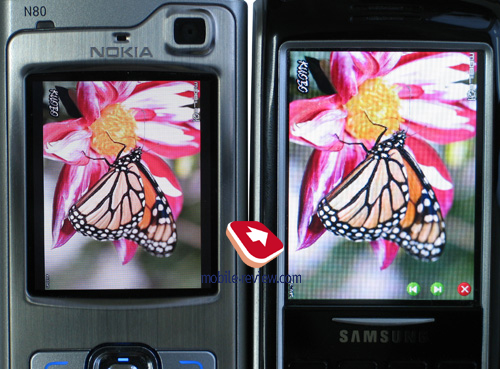
For the moment, this screen is the best among all similar ones. It has the resolution of 352x416 pixels and shows about 252 K colours. Good view angles and colours are not inverted, even at the level grade you will make out the image, however some colours change. Good behavior in the sun, though the screen fades, information may be read without problems. Backlighting is 5 grade. In fact, the only disadvantage of the screen is small diagonal size - 34x41 mm (2.1"), and 2.2" is standard for non-touchscreen smartphones.
The phone's weak point is its BL-5B battery capacious of 820 mAh, it is the same as in Nokia N90. Even using mostly as a phone (40 minutes of talks in Moscow Megafon network, an hour of MP3 and 20 minutes of works with programs), you will hardly have the handset last even for a day. And let alone very fast battery exhaustion when using Wi-Fi. You should be ready to recharge the phone once a day, and the thriftiest ones will manage to prolong the battery life to two days.
Wireless interfaces
Integrated Bluetooth modules have become a standard, and thus we can avoid speaking about it. Here it is 1.2 and the following profiles are supported: Basic Printing Profile, Generic Access Profile, Serial Port Profile, Dial-up Networking Profile, Headset Profile, Handsfree Profile, Generic Object Exchange Profile, Object Push Profile, File Transfer Profile, Basic Imaging Profile, SIM Access profile and Human Interface Device Profile. Several connections at the same time are supported. The main disadvantage is the absence of A2DP profile (Bluetooth stereo).
The handset supports Wi - Fi (IEEE 802.11 g). All security standards are supported (WEP, WPA, WPA 2), the settings are
maximum, though convenience in connection and its simplicity is hard to compare with Zero Configuration in Windows mobile.
That is the first mobile device, which supports Universal PnP (UPnP), the heir of the wire standard PnP. With its help
and using Wi- Fi connection, you can transmit slides to the television set, and music - to the stereo system, photographs
to the printer. To a certain degree UPnP resembles a superstructure above the infrastructure (above Wi- Fi as one of
the versions) in the form of Bluetooth-like services, this is a program superstructure. Thus far the support of the
standard is interesting from a theoretical point of view, the wide acceptance of this standard is a matter of future;
however, even now the list of companies, which support the standard, it impressing. You can get acquainted with a
complete specification of UPnP. Be sure to check a Home Media Server program included into the package. It allows
connecting to a desktop PC via a home wireless network.
Camera
As the camera objective is not closed with anything, you can easily mark it. Traditionally for Nokia's smartphones the camera settings are very rich. Several shooting modes are available in usual mode - Automatic, User, Portrait, Landscape, Sport, Night Landscape (no flash), Night Portrait (flash). White balance settings are AWB, Sunny, Cloudy, Incandescent, Fluorescent. An Exposure Value ranges from -2 to +2. Norma, Sepia, B&W, Negative are available color effects. Three grades are available for image sharpness - Hard, Normal, Soft. You can take a series of photos with the speed from 3 fps to one frame per 15 minutes; you can place the phone on its side and watch the things in the office, for instance. Timer values are 2, 10 or 20 seconds. And finally you cannot switch off the shutter sound.
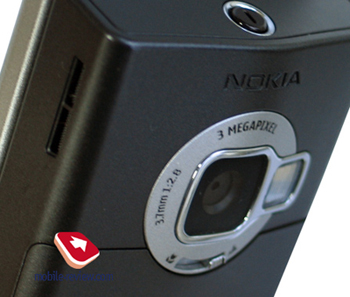
Four resolutions are available:
Resolution:
- 3 ћ Ц Large (2048x1536 pixels)
- 2 M Ц Med
- 1.3 M Ц Small
- 0.5 M Ц Email
- 0.3 M Ц MMS
You can manually switch to macromode (the trigger is near the objective). Then it is possible to take pictures in a distance of 15-25 cm, and a special text shooting mode is available.
Many people laid great hopes on the camera and its quality. Actually, the nominal resolution of photographs grew, but the quality is inferior not only to Nokia N90, but also to Nokia N70 (color rendering, whitening of light regions). Let us hope that the developers simply did not have time to finish software for the new camera module. Any way you should not expect miracles from the camera - there is no auto-focus, flash is useless. The company deliberately avoids competition with another model of the series, which is not represented yet (supposedly N95). And the latter will gladden with the maximum camera capabilities.
|
|
 |
 |
(+)
increase, 2048x1536, JPEG |
(+)
increase, 2048x1536, JPEG |
 |
 |
(+)
increase, 2048x1536, JPEG |
(+)
increase, 2048x1536, JPEG |
 |
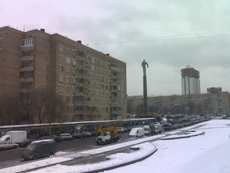 |
(+)
increase, 2048x1536, JPEG |
(+)
increase, 2048x1536, JPEG |
 |
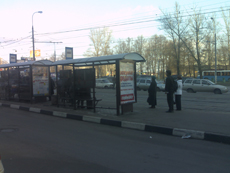 |
(+)
increase, 2048x1536, JPEG |
(+)
increase, 2048x1536, JPEG |
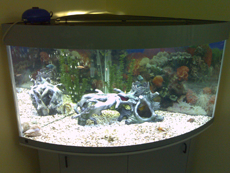 |
 |
(+)
increase, 2048x1536, JPEG |
(+)
increase, 2048x1536, JPEG |
 |
 |
(+)
increase, 2048x1536, JPEG |
(+)
increase, 2048x1536, JPEG |
 |
 |
(+)
increase, 2048x1536, JPEG |
(+)
increase, 2048x1536, JPEG |
 |
 |
(+)
increase, 2048x1536, JPEG |
(+)
increase, 2048x1536, JPEG |
Three resolutions for video can be set - High (MP4), Normal (3gpp), Low (3gpp). And still the quality significantly loses to Nokia N90.
Video sample 2 (mp4, 591 KB)
Software
You can read a special review about the operating system on our site. We will return to this section in a complete version of the review (now necessary software is just absent, for instance, Quick Office and a new WEB-browser, and so on).
Preliminary conclusions
At the current moment this is the most functional smartphone on the market. However, let us return to the list of innovations and dismantle what actually stands behind them.
- The 3MP camera without autofocus and with a useless flash. Not the best photo quality. Nominally the number of pixels grew, and extra macro mode is provided, which are advantages;
- Wi-Fi and a new high resolution screen. That will be a standard for smartphones in 2006, however now that is an innovation;
- UPnP, which is in the start of its route and now it is interesting from only theoretic point of view;
- S60 of the third version. On the one hand these are new capabilities, on the other hand - still no workable third party programs for this operating system (all applications should be recompiled and signed). The situation will have improved only by the middle of 2006;
It turns out that very soon we will see Nokia's devices not inferior in capabilities. The situation with the software will make the most active customers postpone the purchase approximately for half a year, and then another model will become the leader. And any way we should wait for the final product to provide the final verdict. Nokia N80 is expected in sale in February for about 500-550 Euro.
Anton Kotov (anton.kotov@mobile-review.com)
Translated by Maria Mitina (maria.mitina@mobile-review.com)
Published — 16 January 2006
Have something to add?! Write us... eldar@mobile-review.com
|
News:
[ 31-07 16:21 ]Sir Jony Ive: Apple Isn't In It For The Money
[ 31-07 13:34 ]Video: Nokia Designer Interviews
[ 31-07 13:10 ]RIM To Layoff 3,000 More Employees
[ 30-07 20:59 ]Video: iPhone 5 Housing Shown Off
[ 30-07 19:12 ]Android Fortunes Decline In U.S.
[ 25-07 16:18 ]Why Apple Is Suing Samsung?
[ 25-07 15:53 ]A Few Choice Quotes About Apple ... By Samsung
[ 23-07 20:25 ]Russian iOS Hacker Calls It A Day
[ 23-07 17:40 ]Video: It's Still Not Out, But Galaxy Note 10.1 Gets An Ad
[ 19-07 19:10 ]Another Loss For Nokia: $1 Billion Down In Q2
[ 19-07 17:22 ]British Judge Orders Apple To Run Ads Saying Samsung Did Not Copy Them
[ 19-07 16:57 ]iPhone 5 To Feature Nano-SIM Cards
[ 18-07 14:20 ]What The iPad Could Have Looked Like ...
[ 18-07 13:25 ]App Store Hack Is Still Going Strong Despite Apple's Best Efforts
[ 13-07 12:34 ]Infographic: The (Hypothetical) Sale Of RIM
[ 13-07 11:10 ]Video: iPhone Hacker Makes In-App Purchases Free
[ 12-07 19:50 ]iPhone 5 Images Leak Again
[ 12-07 17:51 ]Android Takes 50%+ Of U.S. And Europe
[ 11-07 16:02 ]Apple Involved In 60% Of Patent Suits
[ 11-07 13:14 ]Video: Kindle Fire Gets A Jelly Bean
Subscribe
|


























